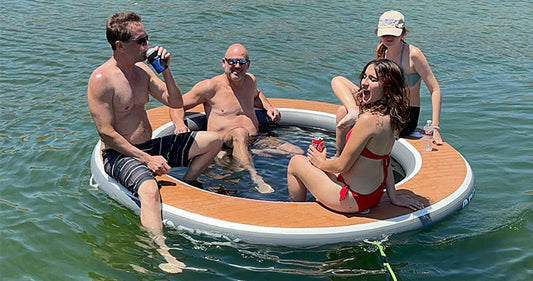7 Tips to Relieve Numb Toes while Paddle Boarding
You take your paddle board to the water on what seems to be the perfect day. You're enjoying every moment, breathing in the fresh air, keeping the strokes smooth, and suddenly your toes go numb. Is this something that has happened to you? It isn't rare for a paddler to experience numb toes while paddle boarding. Luckily, we have some tips on how to help we'd like to share with you!
Fatigue or pain in the feet and ankles are some common problems for stand up paddleboarders. The sensation you feel is caused by standing rigid in a single position for a long period of time as you subconciously grip the board with your toes and feet. Preventing foot pain while stand up paddle boarding is simple and here are the tips we have that work for us. Keep in mind, what works for us may not work for others but we would love to hear your suggestions or opinions!
First and foremost, complete a self-check and ask yourself the below questions:
- Am I relaxed?
- Do I feel any discomfort with my stance?
- Are my knees slightly bent?
- Is my back straight?
- Is my head centered over the board?
- Am I subconsciously gripping the board with my toes?

These basic questions will help you focus and improve your paddling expereince just by recognizing them.
How to help with numb toes:
- Help avoid numb toes by doing some stretches and rotating your ankles gently.
- If your toes are numb, try wiggling them by moving it back and forth for a bit. It's a good way to keep blood flowing through your feet.
- Focus on the weight placement of your feet. Try to shift some of the weight towards your heels that way the majority of pressure isn't on the balls of your feet or toes.
- Bend your knees and unweight your feet as you avoid rocking the board while doing so.
- Keep your eyes on the horizon and allow the board to move through. Try not to fight the movement and let it flow or do what it does on it's own.
- If the numbing persists, take a break. Sit down and rub your feet for a moment to help with ciruclation. When you're ready, you'll be able to stand up on your board and continue paddling.
- If these tips still aren't working for you, look into getting some footwear. Chaco sandals, NRS water shoes, and Vibram five finger shoes work great for many paddlers!
As you advance your paddling skills you can slowly try to shift your weight on the board. This technique is useful not only to prevent footpain/numbness, but can also help you adjust as you learn to tackle large waves.
Here are a few ways you might find yourself on the iSUP:
- Neutral Stance: Position both feet parallel and pointing forward towards the front of the board. It is a great position but can quickly cause numbness in the toes.
- Staggered Stance: This involves turning one foot slightly back from the other as it points towards the water. It will then make the back foot stronger and help balance the weight.
- Hybrid Stance: When standing with one foot pointed forward and the other at a 45 degree angle lining the heels you will maintain balance both edge to edge and end to end. This will allow you to rotate the board edge to edge and rotate the noise to the tail end of the board.
- Full Surf Stance: This will feel unstable unless you are actively surfing a wave. We wouldn't suggest it unless you are taking your inflatable paddle board to surf.
Let us know what works best for you and if any of these tips helped. We would also love any input you have in relieveing numbness from paddle boarding! We love hearing from our NIXY family so feel free to leave any questions or comments as we appreciate all feedback.
Connect with us on Facebook and Instagram to get the latest info.
Happy Paddling from all of us at NIXY!








No comments